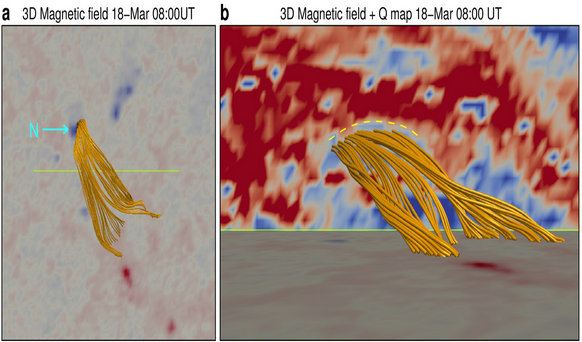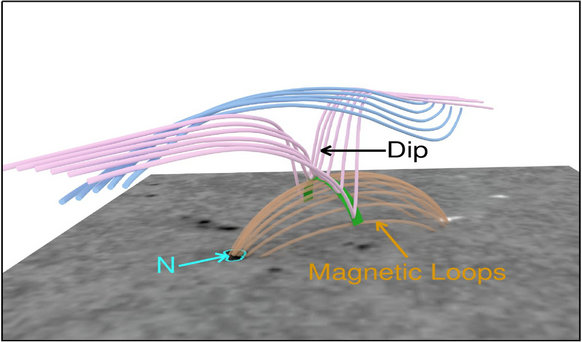Reconstructing 3D Magnetic Topology of On-disk Prominence Bubbles
Solar prominences or filaments are cool and dense plasma structures suspended in the hot and tenuous corona. Recent high-resolution solar limb observations reveal that some dark "bubbles" with bright arch-like boundaries form below prominences.
It is puzzling that how these bubbles, semi-circular voids, form below dense prominences. For unveiling the magnetic nature of bubbles, Ph.D Student Yilin Guo from National Astronomical Observatories of Chinese Academy of Sciences (NAOC), together with Dr. Yijun Hou, Dr. Ting Li, and Prof. Jun Zhang, finds and investigates an on-disk bubble based on stereoscopic observations for the first time.
The study was published in The Astrophysical Journal Letters on 13 April 2021.
"It is widely accepted that bubbles are closely related to the overlying prominence system and could eventually lead to the generation of a coronal mass ejection. This has serious effect on space weather. However, previous studies are all based on the solar limb observations or numerical simulations. If the bubble could be found on the solar disk, we could unveil the magnetic nature of the bubble," said Dr. Yijun Hou, the corresponding author of the study.
Checking high-resolution images from New Vacuum Solar Telescope (NVST), the researchers find an on-disk bubble with a sharp arch-like boundary around a filament barb (Figure 1). Fortunately, this bubble can be simultaneously observed by Spacecraft-A of the Solar TErrestrial RElations Observatory (STEREO-A). Therefore, based on stereoscopic observations, we reconstruct the 3D structure of bubble boundary.

Figure 1: Overview of the on-disk bubble. (Credit: Yilin Guo)
"Then, based on photospheric vector field observations, we further reconstruct 3D magnetic fields and calculate the squashing factor Q map (Figure 2). The Q map depicts a distinct arch-shaped interface. The interface agrees well with the 3D structure of the bubble boundary. Under the interface lies a set of magnetic loops. It is rooted on a surrounding photospheric magnetic patch (N)," said Yilin Guo, the first author of this study.

Figure 2: 3D magnetic topology of the on-disk bubble. (Credit: Yilin Guo)
These results indicate that the prominence (filament) dips (barb) interact with the underlying magnetic loops at some locations. Then, an arch-shaped interface is formed (Figure 3). The interface corresponds to the bubble boundary. Therefore, it is reasonable to speculate that the bubble can form around a filament barb below which there is a photospheric magnetic patch.

Figure 3: Cartoon model of the bubble-prominence dip system. (Credit: Yilin Guo)
"The on-disk bubble is probably not a rare structure. Further studies on on-disk bubble will hopefully answer the key question of whether the bubbles form from flux emergence below a pre-existing prominence, and are important for better understanding of the magnetic topology and dynamic evolution of prominences (filaments)," said Dr. Yijun Hou.
The paper can be accessed at https://iopscience.iop.org/article/10.3847/2041-8213/abee92
Media contact: Prof. XU Ang, annxu@nao.cas.cn